Ohio and the area of The Great Lakes are ideal habitats for different snake species. Some snakes are only known for their high activity levels in the summer.
Cold Northern winters of the state mean only the adaptable species survive here. Many of the snakes found in Ohio may share overwintering spots under rocks or logs.
Many species face declining numbers through industrialization. Some of the common snakes seen on crops are also facing a limiting habitat as the use of pesticides in Ohio drives many species away.
Both venomous and non-venomous snakes are found in different areas of the state, but mainly in the Northern part next to Lake Erie. They come in different colors and sizes that vary up to 50 inches with most species.
Table of Contents
Are There Venomous Snakes in Ohio?
Only 3 species of venomous snakes remain in Ohio. Eastern Copperhead, Massasauga, and Timber Rattlesnakes are the venomous snakes of the state.
All of these snakes have a highly dangerous venom that may require hospitalization. These snakes are found in a summer interval, sometimes spread from April to October.
Much of the lives of these venomous snakes remain unknown as they retreat for overwintering. These venomous snakes may overwinter in the same spot.
Snakes in Ohio
Here are the only 3 venomous snakes left in Ohio. Most snake species in Ohio are non-venomous. Some may still attempt to bite showing aggressive behavior towards humans.
1. Eastern Copperhead
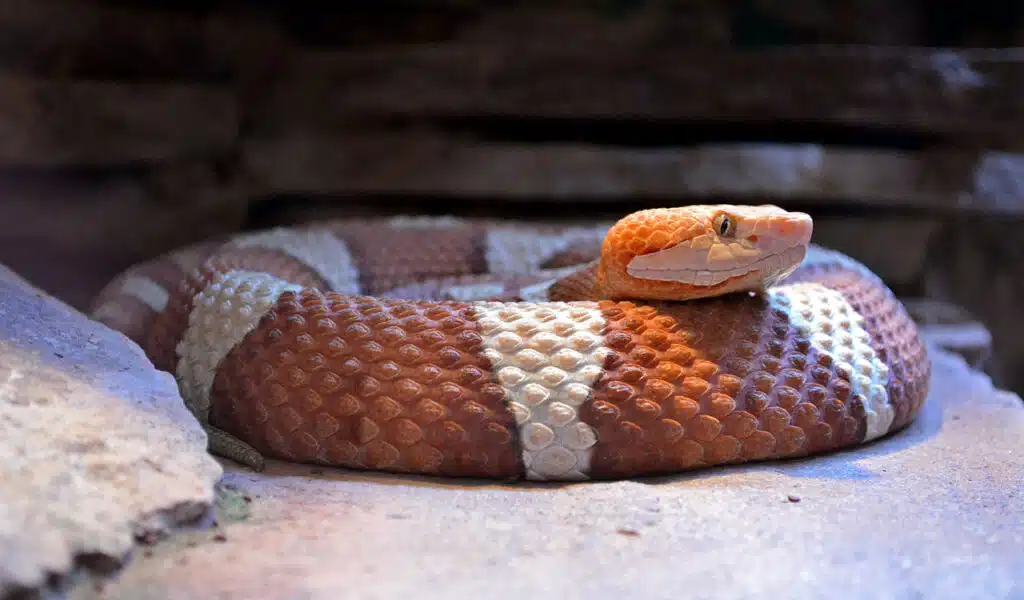
Southern Ohio marks the Northwestern limit of the Eastern Copperhead (Agkistrodon contortrix) in the United States.
This is a highly venomous snake with a robust body of brown to red coloring that grows to a size of up to 37 inches.
Some adults can measure much less, being closer to the smaller size limit of 20 inches the species is associated with.
Eastern Copperheads are very good ambush predators. They take advantage of their camouflaging colors to await for prey to come into their range before attacking.
These snakes are also known to share their habitat with other venomous snakes of Ohio, such as the Timber Rattlesnake.
This species is adapted to the cool weather of the North but it overwinters in sheltered locations to escape cold weather.
Crevices are ideal retreats for Eastern Copperhead overwintering.
2. Massasauga
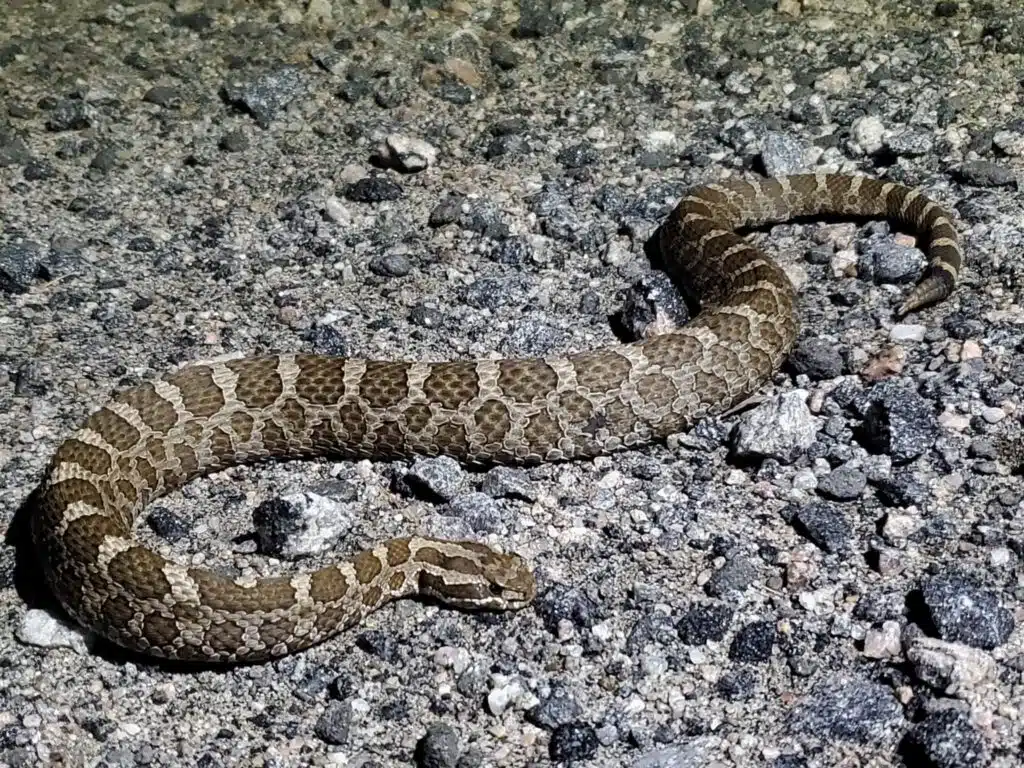
Massasauga or Massassauga Rattlesnakes (Sistrurus catenatus) are one of the 3 venomous snakes of Ohio. This is a well-known species with a large impact on the ecosystem as a true carnivore.
A dangerous species that require hospitalization in the eventuality of a bite, this snake is also an avid hunter.
It begins its predatory approach in its juvenile days when it eats frogs and other small invertebrates such as centipedes.
This species then moves on to vertebrates and mammals as it grows and matures.
Mice and shrews are among the most common prey preference for the species.
The species is an avid predator but many kill it out of fear. This is why it faces diminishing numbers with only neighboring Michigan showing stable Massauga numbers.
3. Timber Rattlesnake
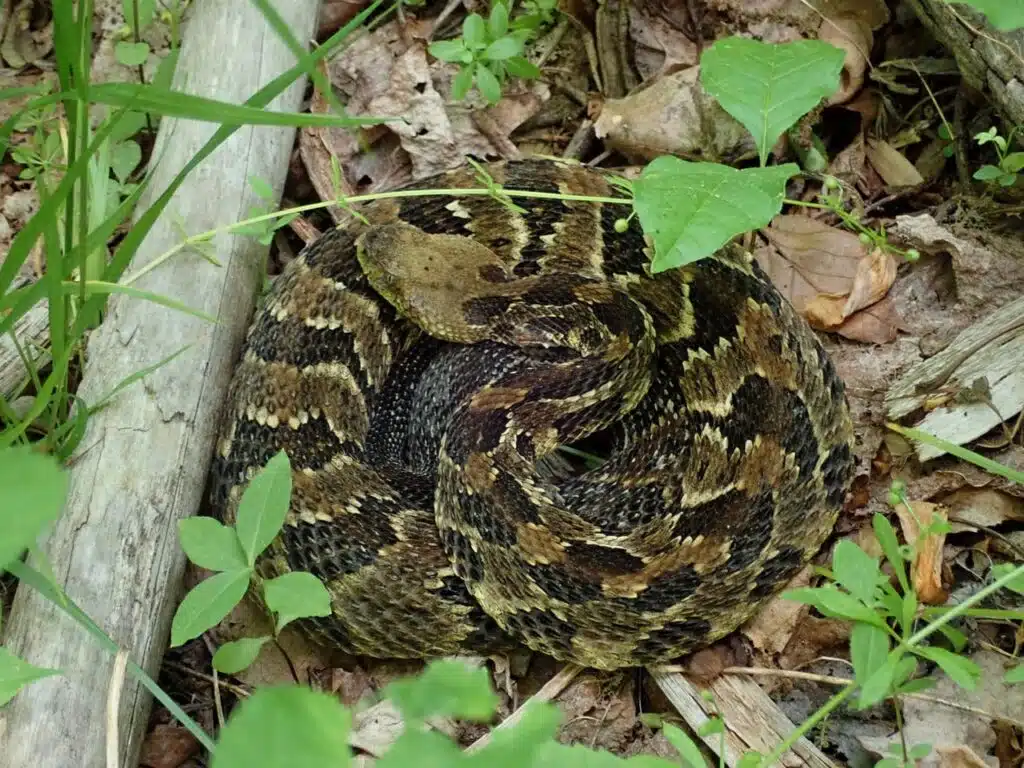
Timber Rattlesnakes (Crotalus horridus) are a venomous snake species found in Southeastern parts of Ohio.
As a highly venomous species, this snake can even kill humans but it rarely injects sufficient venom to cause fatalities.
Timber Rattlesnake bites are still rare in the state. The rates of the bites are considerably smaller than those in other states such as Iowa.
This is an active hunter that moves in its habitat for prey and not an ambush predator sitting for prey to come around such as the Eastern Copperhead.
It uses scent through chemical cues to find different types of vertebrates to eat.
Timber Rattlesnake can also eat other snakes, including juvenile venomous Eastern Copperheads. However, this snake prefers to eat non-venomous species such as Common Garter Snakes.
Its typical prey also includes various species of birds.
4. Common Garter Snake
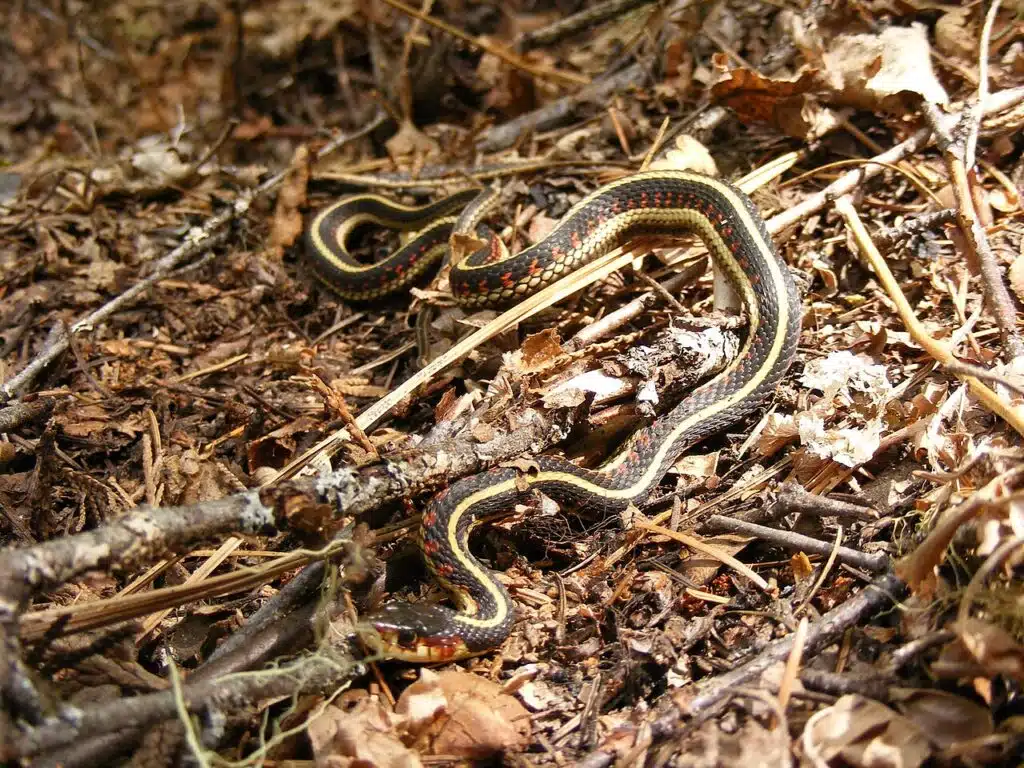
Common Garter Snakes (Thamnophis sirtalis) are among the most widespread non-venomous snakes in the state.
Their common nature makes them vulnerable to other species that eat snakes. Juveniles are often eaten by Timber Rattlesnakes.
Fish and birds routinely eat Common Garter Snakes as well.
Hawks and bullfrogs can eat the juveniles of the species, together with foxes.
Adopting different defensive body postures is one of the ways Common Garter Snakes try to defend themselves from a long list of predators.
While non-venomous, Common Garter Snakes still produce venomous saliva.
This saliva is used against small predators but also as a measure to protect their digestive system from the toxins of certain prey, such as newts.
The venomous saliva Common Garter Snakes have is used against various frogs and toads as a means of overpowering them.
5. Lake Erie Watersnake
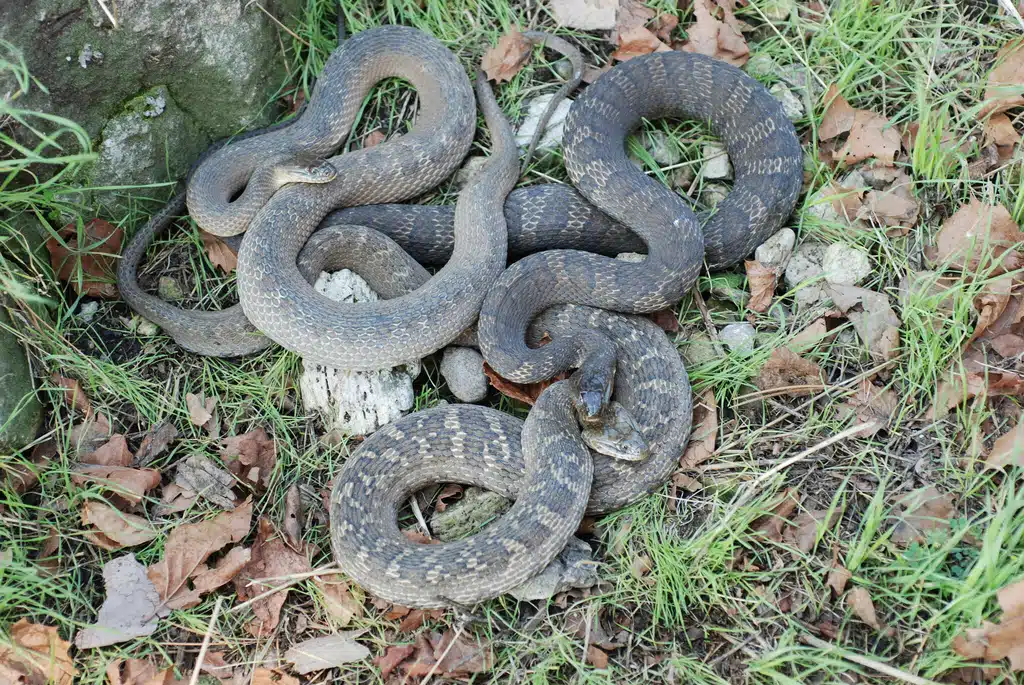
As the name implies, this (Nerodia sipedon insularum) is an aquatic species found around Lake Erie.
It never travels too far from the shore of the lake. It stays within hundreds of yards of the lake all the time.
This dark snake-like rocky shoreline is around the lake. It has a short body never growing more than 28 inches as an adult.
Snakes of this family have changed their diet completely following changes in the aquatic species of the lake over the last 3 decades.
Lake Erie used to feed these snakes with fish and some frogs.
However, the invasive round goby eventually killed local fish and the Lake Erie Snake now eats this invasive species almost exclusively.
Some of the largest actions against these snakes also took place decades ago when the species was wrongly believed to be venomous.
6. Northern Water Snake
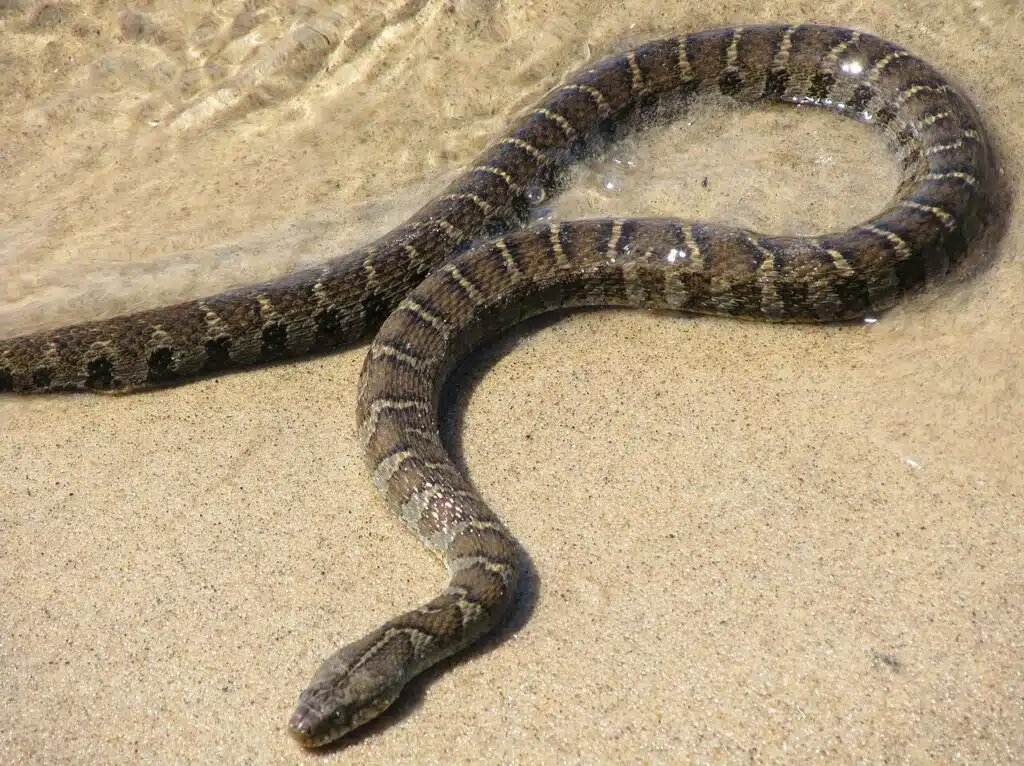
Wrong species identification and assumptions of a venomous status are also linked to the Northern Water Snake (Nerodia sipedon sipedon).
This species is aggressive and this led to the false assumption of its venomous status.
As Lake Erie Watersnakes, some people also used to believe the Northern Water Snake is venomous, killing many snakes of the species.
This snake darkens as it ages and it can be spotted on lake shores during the day. Northern Water Snakes are both diurnal and nocturnal.
Some of its preferred daytime prey includes frogs and other types of vertebrates in or around water.
At night, its prey mainly consists of fish. It swims in shallow waters to find fish that are easy to catch.
This snake also has plenty of natural predators, similar to the Common Garter Snake.
It bites once or multiple times to sway its predators away, unlike the Common Garter Snake which first uses various posture movements.
7. Dekay’s Brownsnake
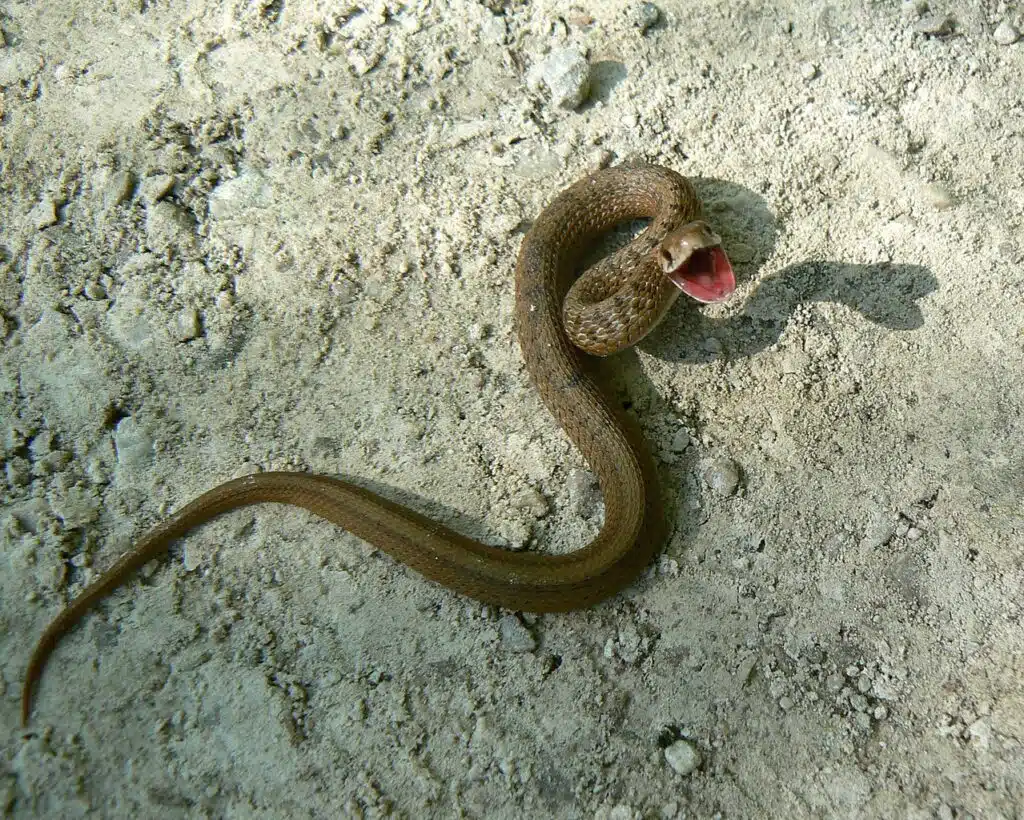
Dekay’s Brownsnakes (Storeria dekayi) may also be seen next to various bodies of water.
This is also one of the smallest species in the state with many adults reaching a maximum size of 12 inches.
The brown snake species also eats small invertebrates such as slugs and snails.
Females of the species may be more active in the summer when they give birth to live young.
While not caring for their young, females often look for suitable places to give birth to a group of juveniles.
Up to 10 juveniles are born from one sexually mature and mated female at the end of the summer.
A non-venomous species, Dekay’s Browsnakes can be handled both as juveniles and as adults as they rarely bite.
8. Gray Ratsnake
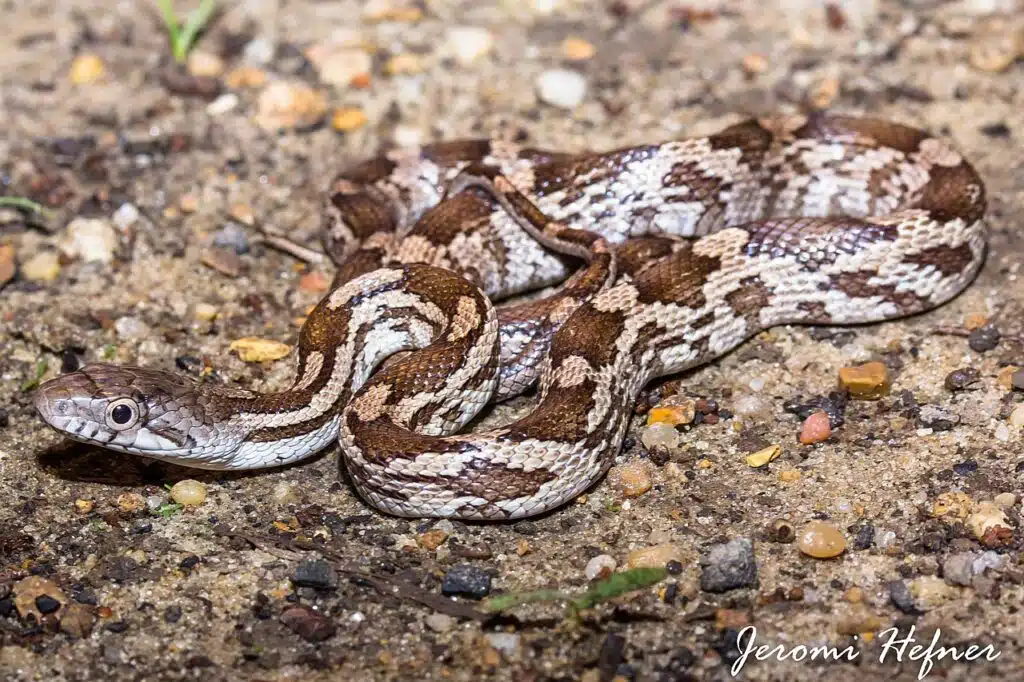
A species found across woodlands, Gray Ratsnakes (Pantherophis spiloides) are still common in Ohio, unlike in other nearby states such as Michigan.
Mostly black color is specific to Gray Ratsnakes which may also be brown or light brown in their juvenile period.
This is a type of snake that lives in areas with plenty of rats and it can also climb for food or as a means of escape.
Gray Ratsnakes are some of the most common constrictors in the state. They suffocate rodents with their powerful constriction.
Frogs and even birds are constricted by this climbing species. Eggs are sometimes eaten by the snake when it climbs on trees.
9. Eastern Milksnake
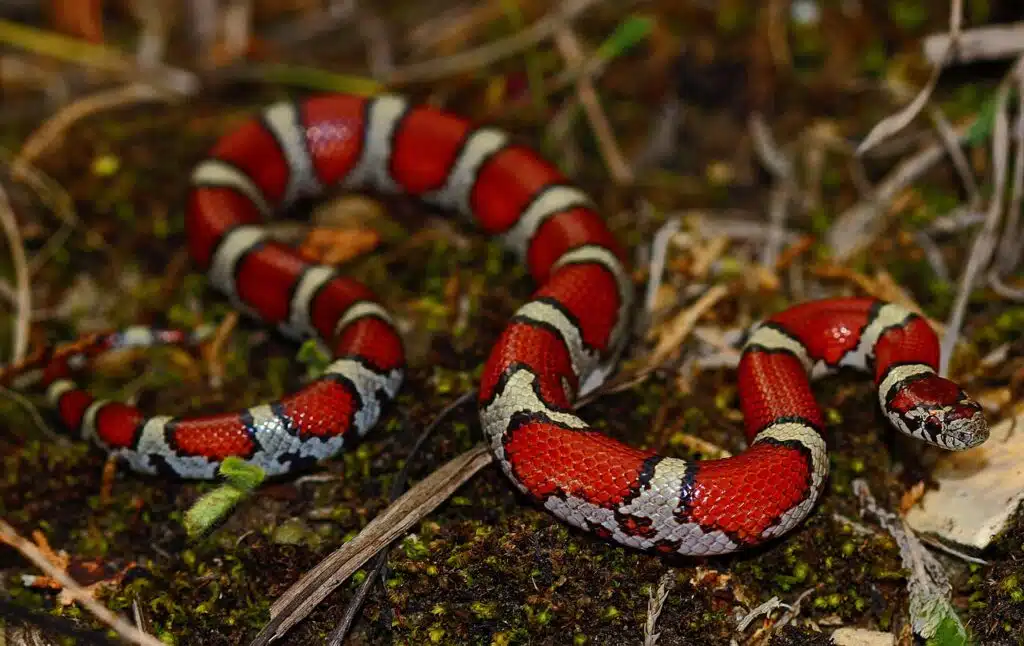
The range of the Eastern Milksnake (Lampropeltis triangulum) expands from Ohio to the Southern parts of Canada.
Large red blotches on the dorsum with white and black coloring are specific to the snake, which is also spotted in brown-dominating colors.
The red-brown sections of the snake vary in width according to its region.
A small constrictor, the snake lives in different habitats where it can find rodents.
The general behavior of the species is docile. The snake uses different techniques to keep predators away which it also shows in front of humans.
This includes hissing. Eastern Milksnakes can also shake their tails vigorously.
Spending most of its time hiding in leaf litter, the snake is rarely surprised so that it bites.
10. Ring-necked Snake
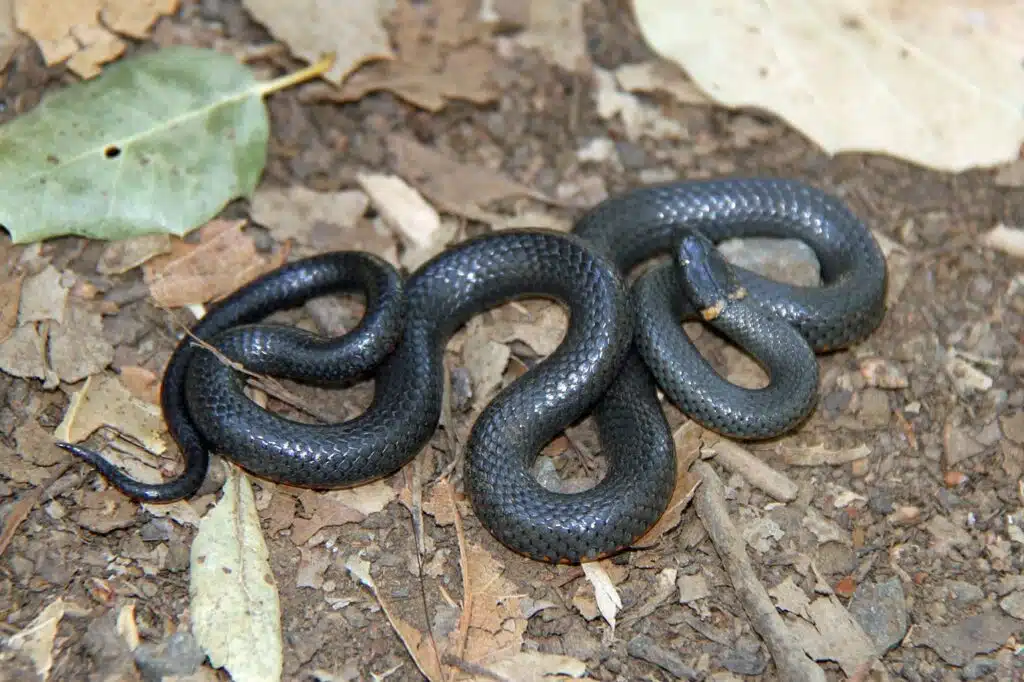
Ring-necked Snakes (Diadophis punctatus) are found around woodlands and other areas of the state where they can hide in leaf litter.
The snake is seen in multiple morphs but it’s known as a species with a bright ring-like pattern behind its head.
It has a plan dorsal color which improves its camouflage. Earth-like olive nuances are specific to its dorsal coloring.
On the other hand, this snake has very bright underside coloring. Its ventral colors can be red, orange, or yellow.
It shows its ventral coloring when it wants to keep predators away by rolling over and looking like a poisonous species.
The snake is known to only eat soft-bodied prey. Earthworms make up the bulk of their diet.
11. Queensnake
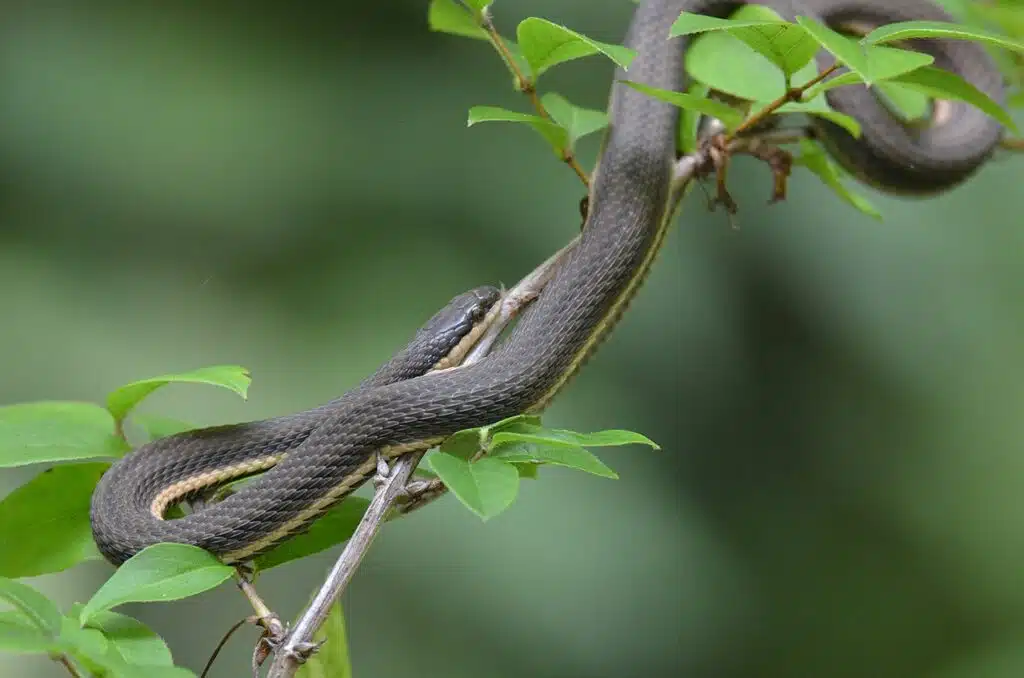
Queensnakes (Regina septemvittata) are some of the most common species in Ohio waters.
This is also one of the examples of olive snakes in North America as this green nuance marks its dorsal and part of its ventral coloring.
Queensnakes like some of the cleanest waters in the state as this is where they can find plenty of crayfish to feed on.
However, Ohio is currently undergoing an invasion of Rusty Crayfish which means Queensankes might only eat this species.
Central parts of Ohio and Western parts of Ohio are among the most common areas of the crayfish and the snake species.
Queensnakes prefer freshly-molted crayfish due to their softer texture as they’re easier to eat.
As a rare alternative, these snakes may also turn to small fish as they prefer only certain types of crayfish.
12. Eastern Foxsnake
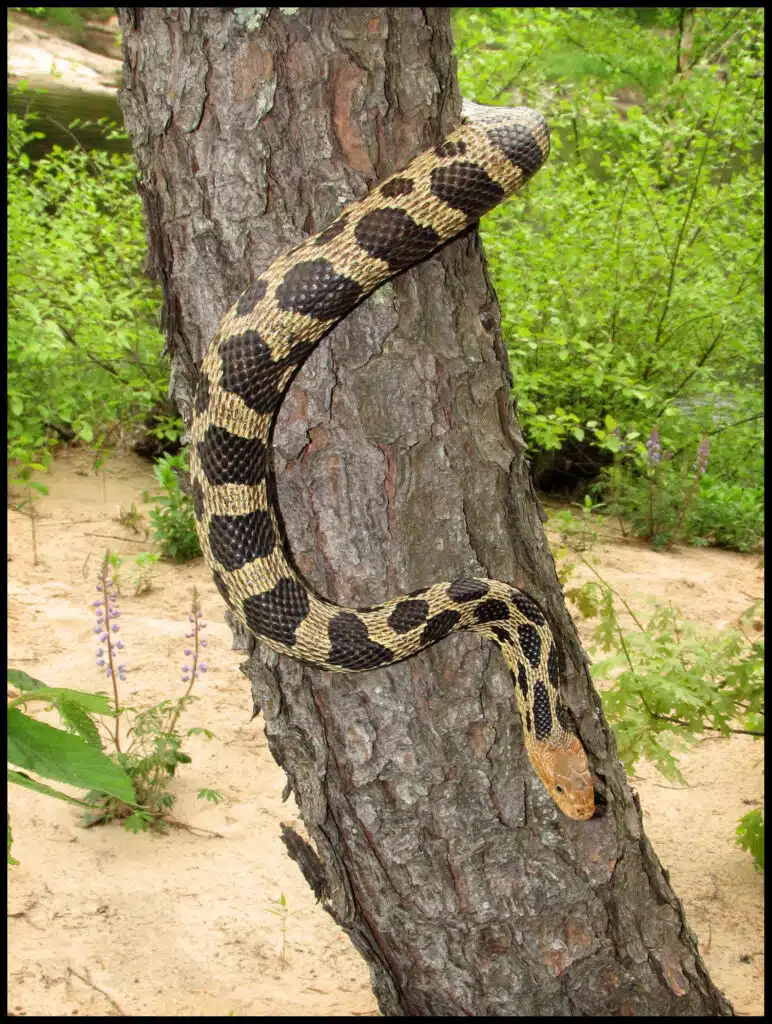
Eastern Foxsnakes (Pantherophis vulpinus) have a yellow-brown color with black patterns and an orange-to-brown head.
Another common morph of the species is based on gray and black colors which turn to mostly black coloring in adulthood.
These are some of the carnivore species in the state that aren’t constrictors and which swallow whole prey.
The species is known to live in suburban areas, farms, crops, and on meadows. It occasionally comes in contact with humans.
The result of the encounter is the species releasing a foul smell that inspires its name.
As a non-venomous species, Eastern Foxsnakes take on the name of foxes as they are assumed to smell similarly to foxes.
Mice and rodents are among the typical prey of the species. Larger Eastern Foxsnakes can also swallow rabbits.
13. Black Racer
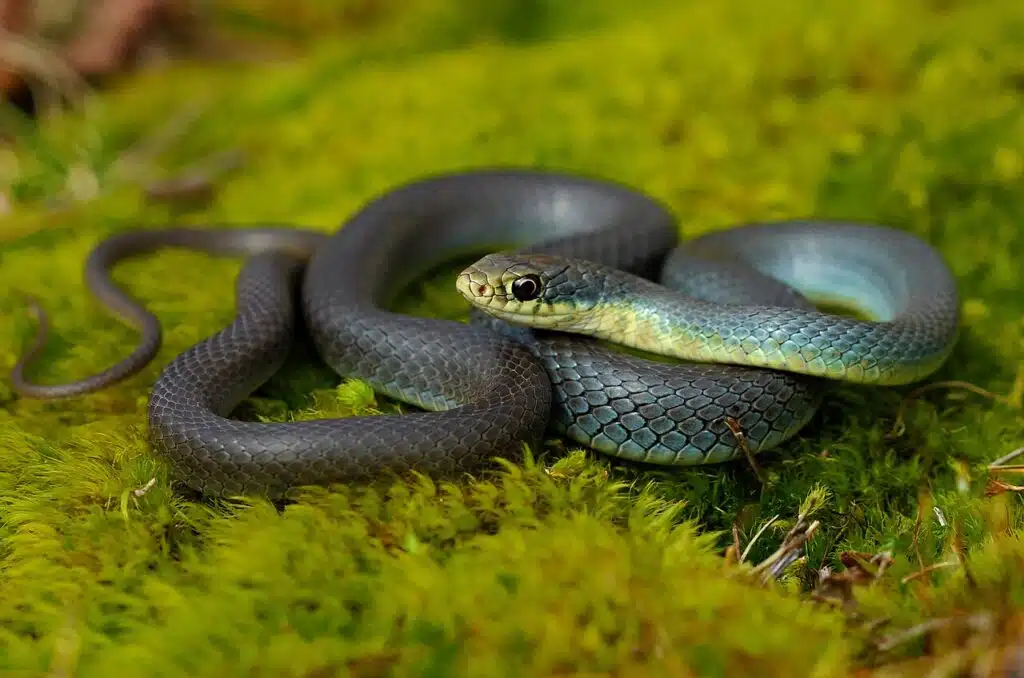
Very good vision is characteristic of Black Racers (Coluber constrictor) which can see further than other snakes.
They rely on vision to locate prey and not on scent or pheromones like other types of snakes.
You can identify the species in different try habitats with vegetation by its black color.
The species has uniform dorsal coloring and uniform almost pure-white ventral coloring. Smooth scales are also specific to the Black Racer.
A narrow head is specific to this species. However, the head is still wider than its body, unlike in insectivore species.
The presence of these snakes in Ohio is widespread. Black Racers inhabit the entire Northern and Northeastern parts of the country in large numbers.
Frequent sightings are characteristic of this snake as it’s both diurnal and a very active snake.
14. Blue Racer
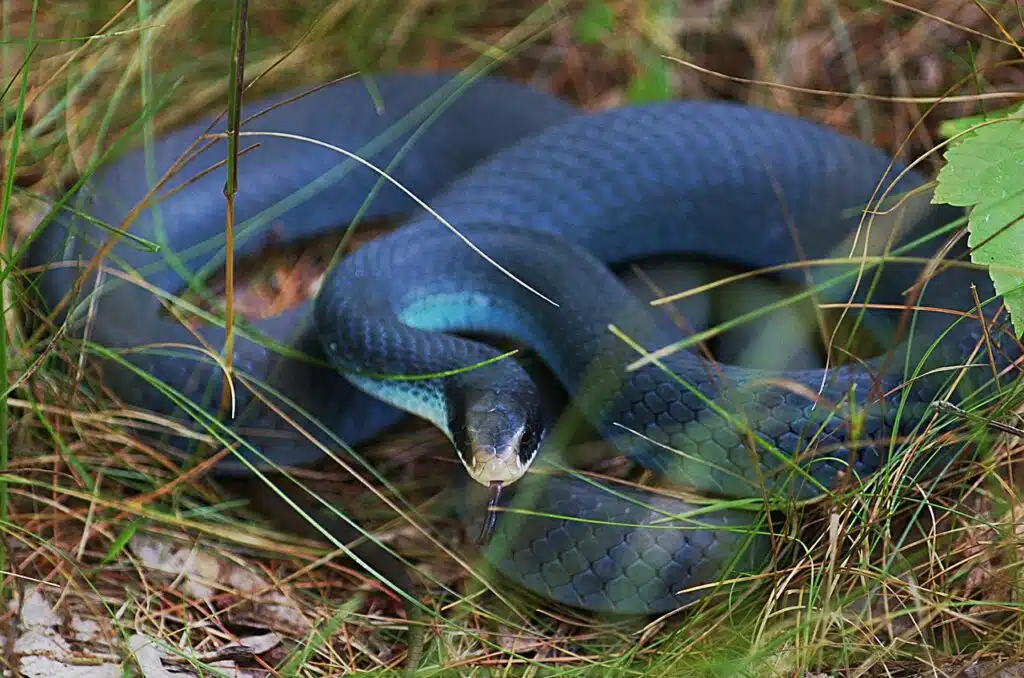
Blue Racers (Coluber constrictor foxii) are among the rare species with blue coloring in Ohio. The blue color is specific to its lateral sides.
Some Blue Racers don’t have blue coloring while others show faint blue lines along their almost black dorsal color.
White color is specific to the ventral side of the species.
An active predator, this snake can be seen looking for food in dry habitats. It represents one of the species with a highly active nature, always moving around for food.
Even juvenile Blue Racers are known for their overall activity levels which allow the species to be active from the first days of its life.
However, juveniles can only eat bugs and insects.
Juvenile Blue Racers also serve as food for other predatory species, particularly hawks.
15. Red-bellied Snake
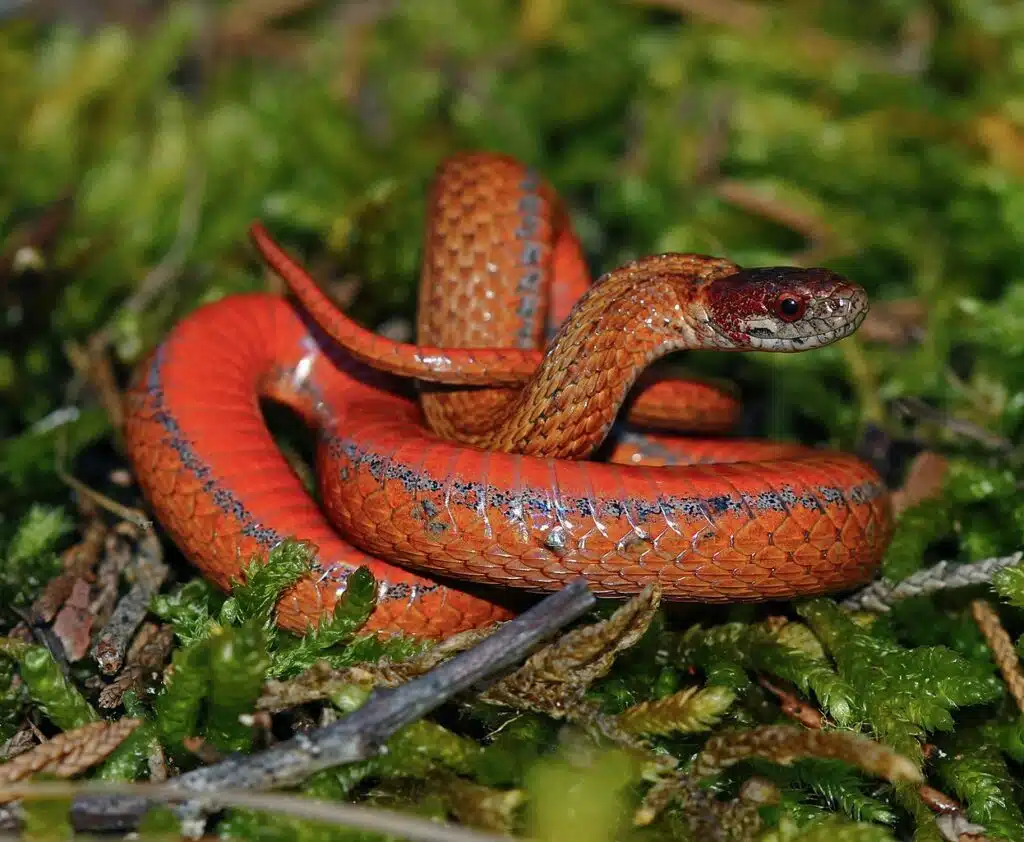
This species (Storeria occipitomaculata) has a dark gray to brown dorsal color and it may be found in the Northeastern territories of the state.
Rare morphs of the species may be more colorful. An orange morph of the snake also exists, but it’s rarely seen.
It’s also found in small numbers in the Western parts of the state.
The species is a burrower or it shows burrowing tendencies on loose soil. Red-bellied Snakes are often known to recycle old ant nests for hiding.
Abandoned ant mounds are known to be favored by the species as they are easier to burrow into.
These are also ideal places for the female Red-bellied snake to lay eggs.
Up to 9 eggs are laid by females at the end of the mating season.
16. Eastern Ribbon Snake
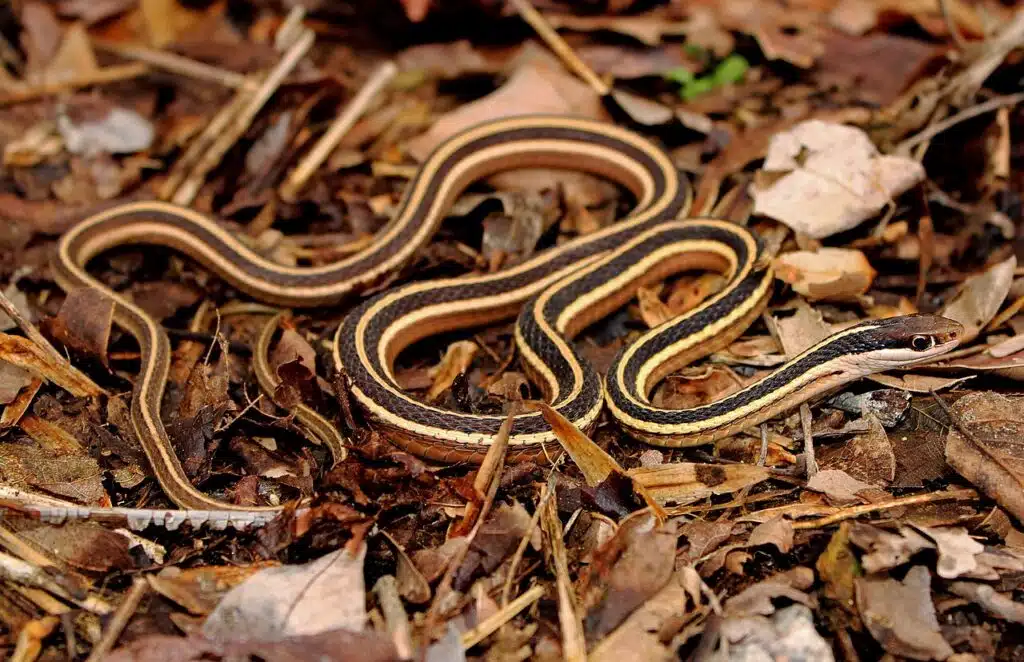
Eastern Ribbon Snakes (Thamnophis sauritus sauritus) are some of the longest slender species in the state.
This thin snake can grow to a size of over 30 inches even if it measures 22-25 inches on average.
Snakes of this genus have a striped dorsum which makes them stand out in some areas but which acts as camouflage in thick vegetation.
Found on the shores of lakes, this species feeds on fish, frogs, and toads. It can also eat other types of prey, depending on habitat variation.
It shares some burrowing tendencies with the Red-bellied Snake as both species can repurpose old ant mounds to hide in or to lay eggs in.
Ant mounds are also an ideal secluded place for the Eastern Ribbon Snake to overwinter in.
17. Northern Ribbon Snake
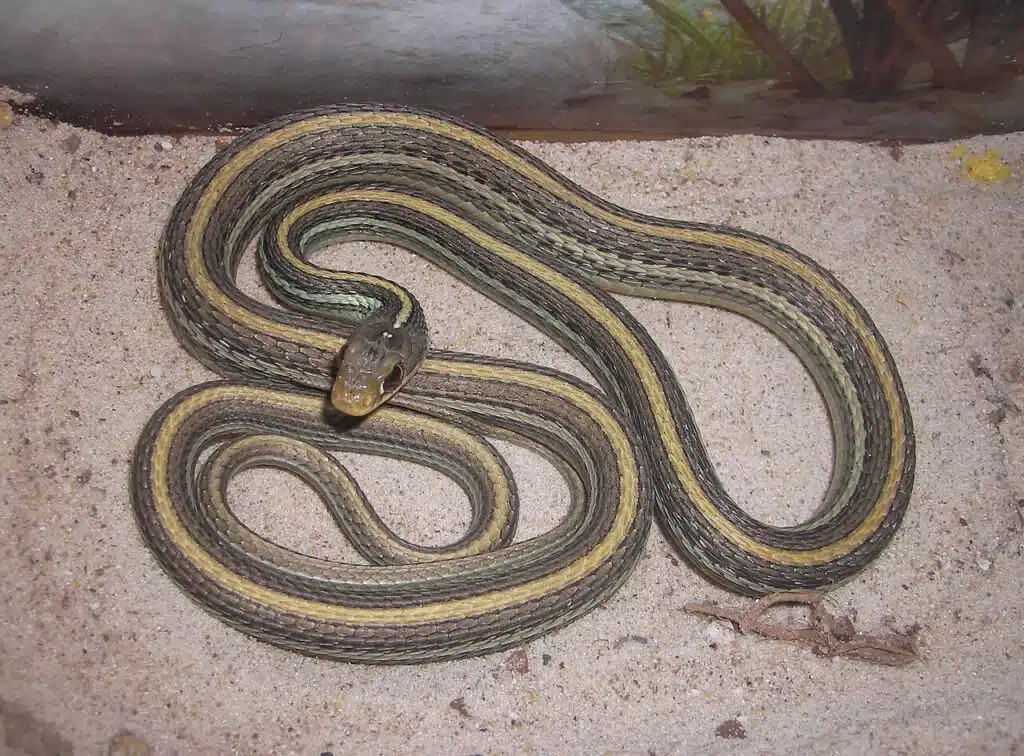
The Northern Ribbon Snake (Thamnophis sauritus septentrionalis) is a very similar species with a striped body.
It lives in secluded areas in woodlands or close to water. Its striped body helps it remain undetected under leaf litter or in dense vegetation.
The snake is one of the short species of snakes found in Ohio that aren’t fossorial.
It barely grows to a size longer than 20 inches with only the largest snakes of the species measuring up to 26 inches.
Small fish are some of its favorite types of food. Salamanders that share its forested habitat are also commonly eaten by this snake.
Abundant in Ohio, this species is now seen as an endangered species in other states.
18. Eastern Hognose Snake
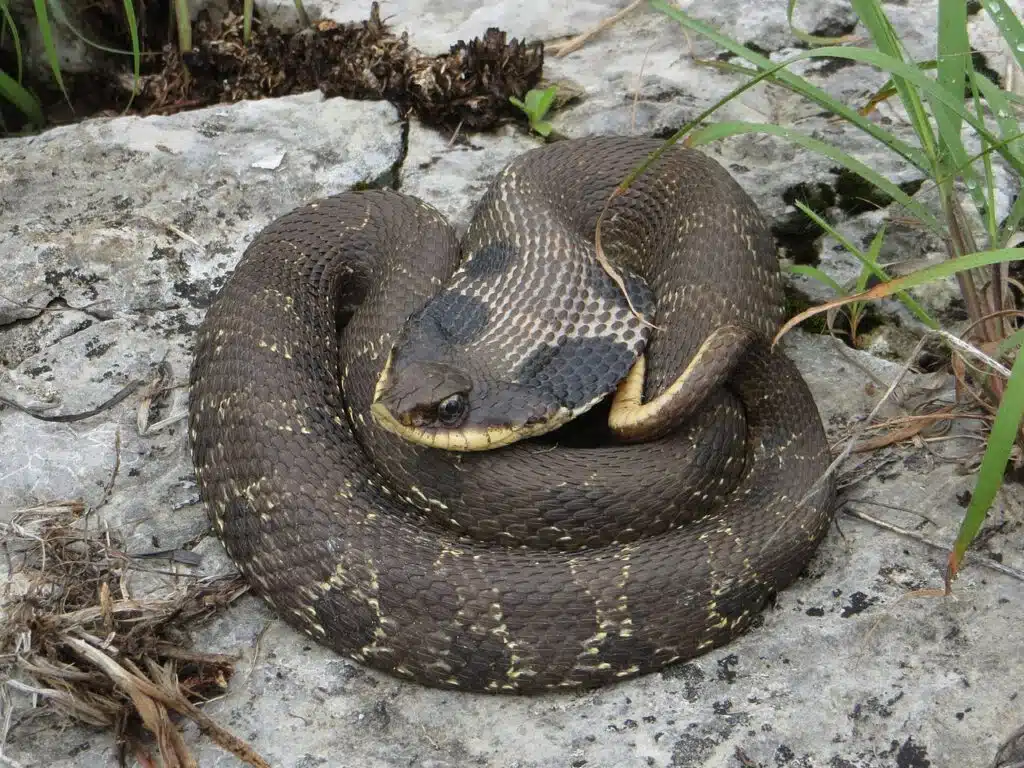
Eastern Hognose Snakes (Heterodon platirhinos) are among the few species with venomous saliva.
This is not the pure venom of venomous snakes but an adaptation that allows the species to eat toads.
The toxins in its venomous saliva aren’t harmful to humans. They are only harmful to their small prey such as toads.
Eastern Hognose Snakes are specialized in eating toads which means they share the same humid habitat, both around temporary and permanent bodies of water.
The venomous saliva of the species allows it to survive on toads in this environment and to cancel the effect toad skin secretions have.
19. Rough Greensnake
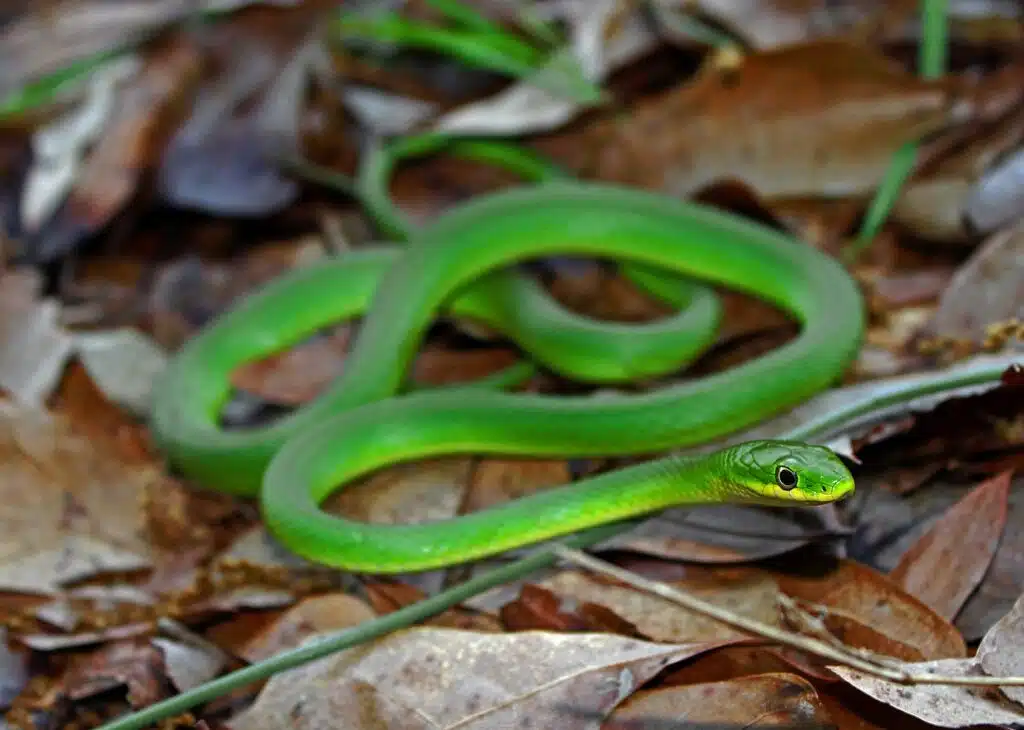
Rough Greensnakes (Opheodrys aestivus) are the most common arboreal species in the state.
They have green dorsal coloring and they can be spotted climbing on trees. A diurnal species, these snakes are spotted climbing around the edges of woodlands.
Rough Greensnakes don’t bite humans but they prefer to avoid contact with people or other larger animals.
Fleeing is the only true measure they have to escape. Often resorting to climbing, Rough Greensnakes can still fall prey to flying predators.
This species breeds in large numbers due to having both spring-time and fall-time mating seasons.
20. Eastern Worm Snake
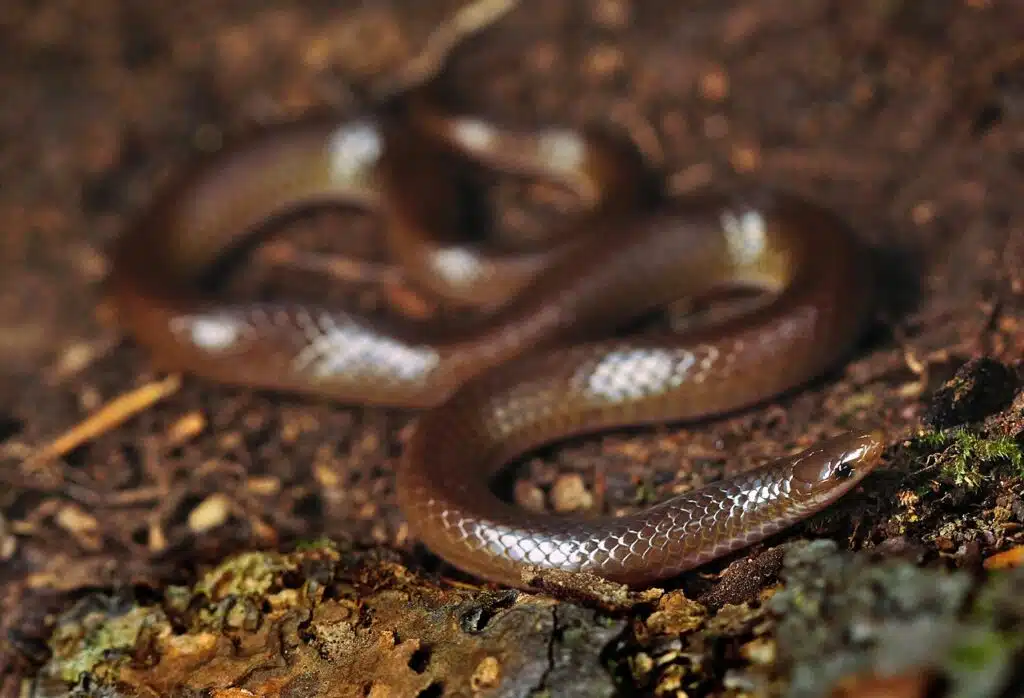
Eastern Worm Snakes (Carphophis amoenus) are one of the secretive species of Ohio. This is a fossorial snake that isn’t seen outside on rainy days.
Spending most of its life underground, The Eastern Worm Snake is among the species that take on the color of their habitat.
Brown is the main morph in this case, even if black and red morphs of the species also exist.
Eastern Worm Snakes remain secretive even during their mating season.
This is a species that lays eggs at the beginning of June. This is a process that lasts up until Mid-July.
Eggs are laid in the ground or under leaf litter and can’t be easily spotted by other snakes.
21. Smooth Greensnake
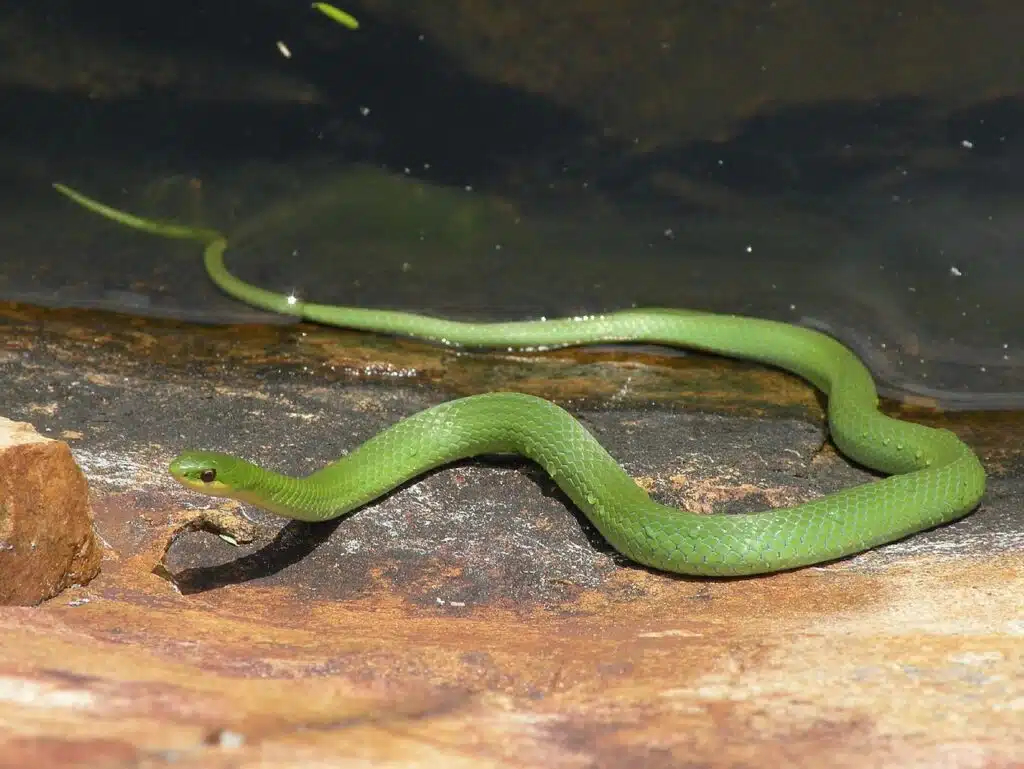
With a similar look to the Rough Greensnake, Smooth Greensnakes (Opheodrys vernalis) are found on the ground and rarely up on trees.
The snake is a common sight around marshes and bodies of water such as lakes and ponds.
It also prefers to live in woodlands next to a source of water.
Smooth Greensnakes are often uncovered with other species in the state that don’t overwinter in rock crevices.
These snakes are often seen retreating to abandoned ant mounds to overwinter.
Rat burrows are often their alternative overwintering spots. But they may end up eaten by venomous snakes here.
22. Butler’s Garter Snake
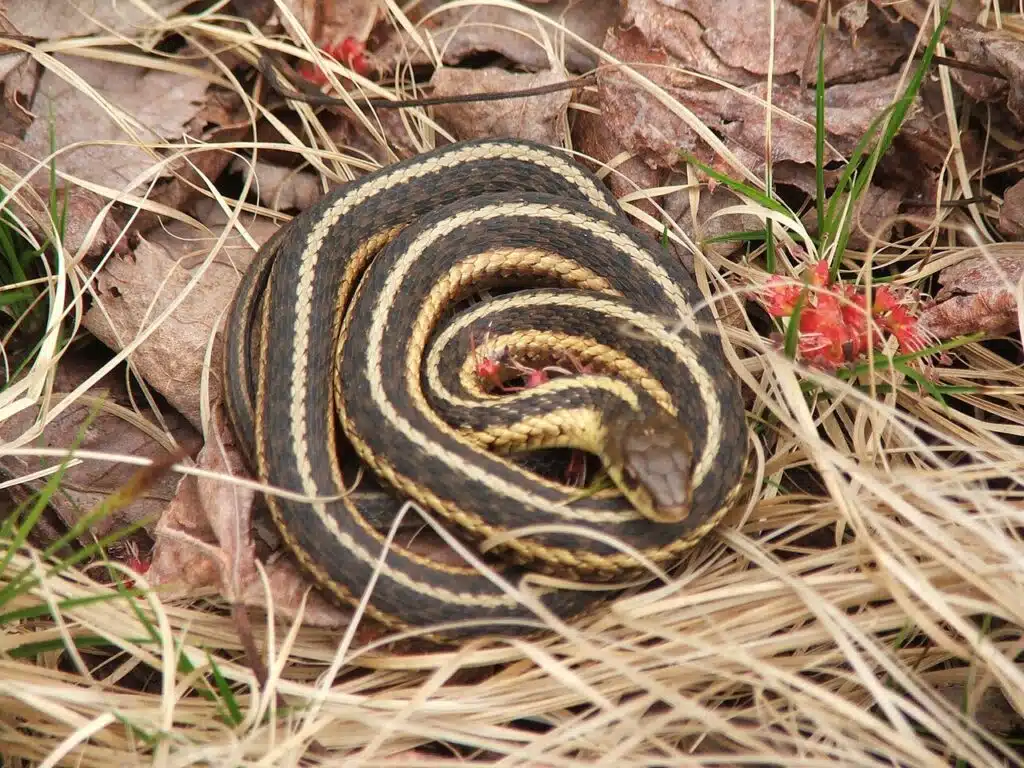
This species (Thamnophis butleri) is identified by its contrasting dorsal stripes. Almost completely black, this species has bright central and lateral stripes.
A cream-to-white mid-dorsal stripe is specific to the snake. Darker stripes closer to yellow are spotted on its sides.
Buttler’s Garter Snakes are among the species that can overwinter together with Smooth Greensnakes.
These snakes are always found in burrows with other snakes for overwintering.
Butler’s Garter Snakes have striped bodies and remain largely elusive due to their burrowing nature.
Growing to a maximum length of over 20 inches, Butler’s Garter Snakes might not reach this size in the absence of soft-bodied prey.
The snake largely feeds on earthworms and slugs.
23. Kirtland’s Snake
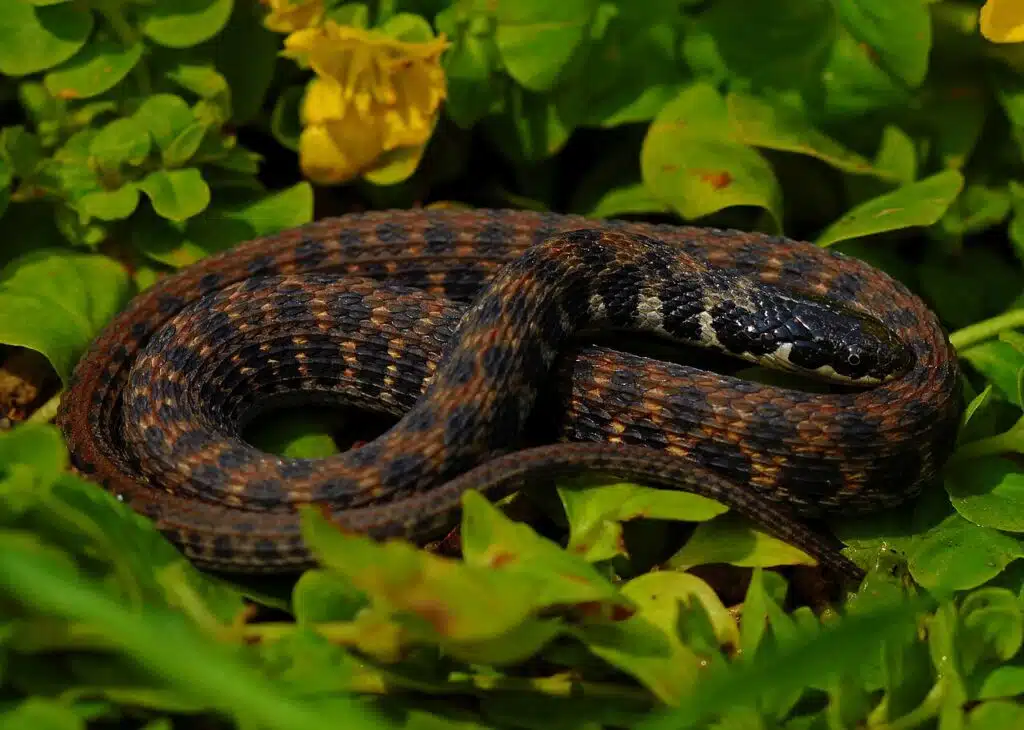
Also known as The Little Red Snake, Kirtland’s Snake (Clonophis kirtlandii) is a species found all around Ohio.
The natural habitat of the species is closely tied to the area of The Great Lakes. This makes the species rather commonly locally but not known on the Eastern Coast.
Kirtland’s Snakes are among the species living in areas close to water although it’s not purely aquatic species.
Woodlands and especially woodlands close to lakes, ponds, and streams are its preferred habitat.
It’s here that the snake feeds on various prey such as frogs, abundant in wet areas. Salamander is also eaten by this snake in woodlands.
This is a species that possesses different defensive techniques sometimes shown when seeing humans.
Becoming very rigid is one of the ways the snake tries to play dead with.
Kirtland’s Snakes may also use coiling techniques to avoid a direct attack. They make their bodies appear smaller by spiraling into a round shape which also helps reduce the areas of the body predators can bite.
24. Black Kingsnake
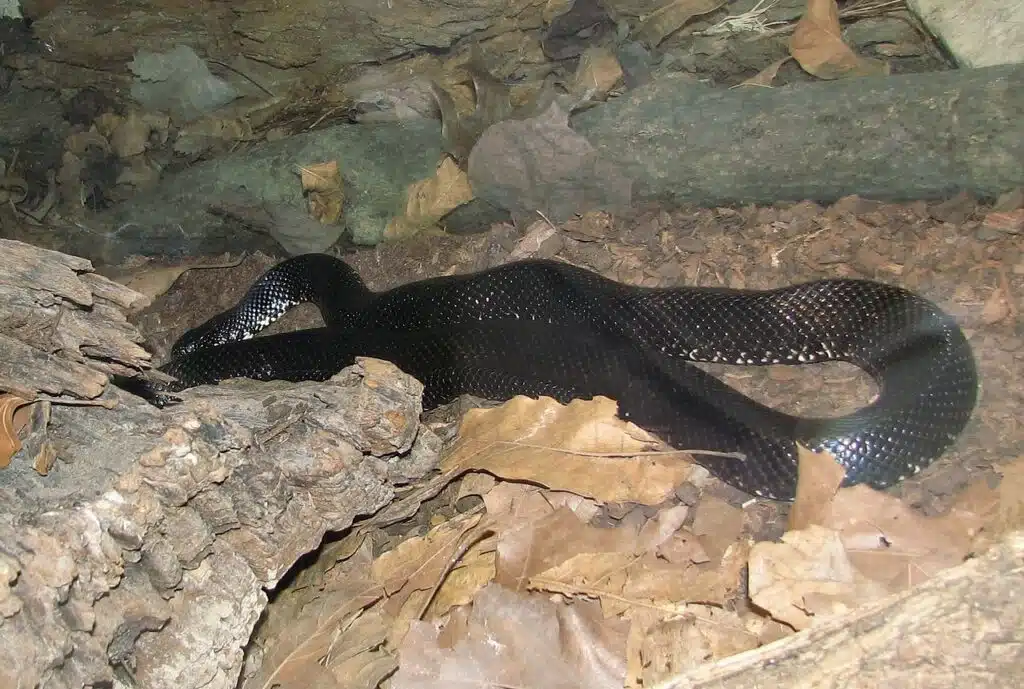
Also known as The Mole Snake, this (Lampropeltis nigra) is a species dominated by its black color. Shiny black scales cover its body with just a few white or off-white tiny marks.
The ventral side of the species is mostly white.
Black Kingsnakes are medium to large-sized as they can reach lengths of more than 50 inches.
Some of the largest Black Kingsnakes ever to be measured reached sizes of more than 70 inches. Most snakes in the state are shorter, measuring around 40 to 50 inches.
Black Kingsnakes are highly adaptable. They can move around easily from a dry to a moist habitat.
Common across woodlands, these snakes are also found in marshes.
Prairies aren’t a common choice for this snake unless transformed from abandoned farmland.
Areas next to water such as marshes, drainage areas, and typical floodplains are common sights for this species as well.
25. Smooth Earthsnake
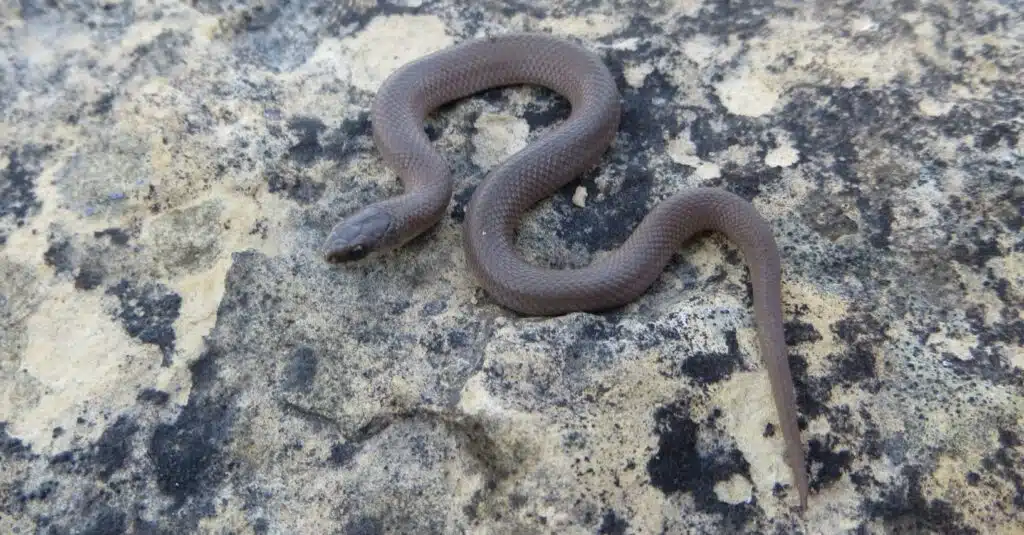
Smooth Earthsnakes (Virginia valeriae) are some of the smallest types of snakes found in Ohio.
This is a small species known for its secretive nature. Smooth Earthsnakes have a constant presence in moist loose soil.
Much of their lives are spent underground or above the ground but still hide under leaf litter.
This is a small snake that uses defensive techniques such as releasing feces to keep predators away.
While small the snake can attempt biting. Its bite is not painful or long-lasting as it only has tiny teeth which cannot pierce human skin.
Seeing this snake is a rare event and its bites are also rare. Stepping on the snake might expose you to the only situation when it can bite.
26. Plains Garter Snake
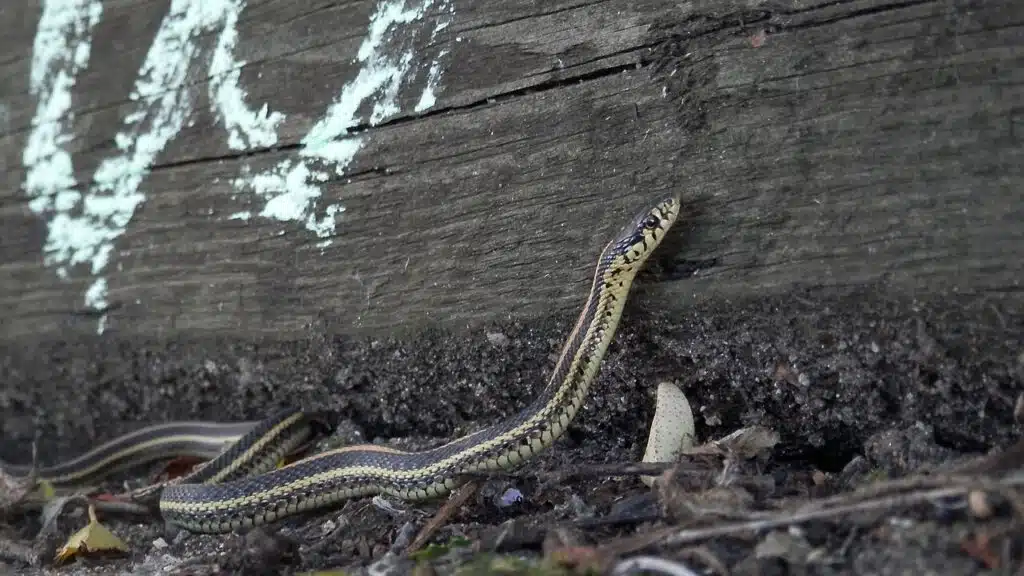
The Plains Garter Snake (Thamnophis radix) is one of the species that rely on coloring to steer predators away.
An orange central stripe is distinguished on its dorsum while yellow to white stripes are seen on its sides. A dark gray to black base color is specific to this snake.
A white base ventral color distinguishes the snake further.
It can be found in the Northern parts of the state around ponds, lakes, and streams.
This species used to be a common sight on farmland but its numbers have been reduced or even eliminated from these habitats.
The use of chemicals on crops reduced the number of species.
Once a common sight in suburban areas next to towns and cities, this snake is also facing diminishing numbers in these areas based on heavy industrialization.
27. Short-headed Garter Snake
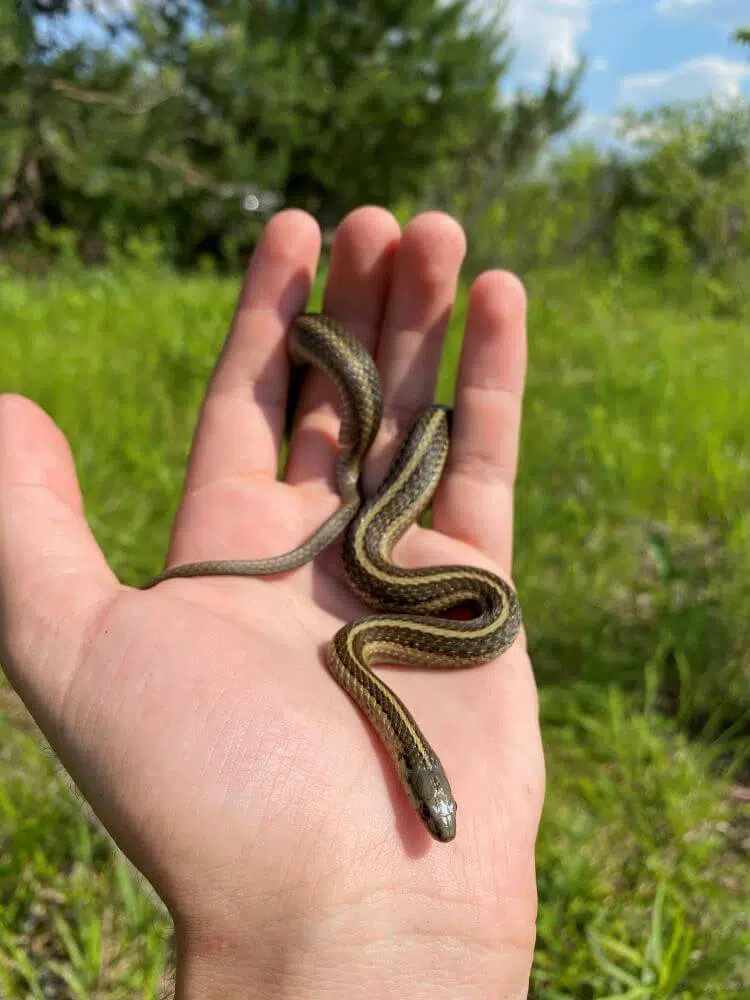
Sometimes confused with various worms, the Short-headed Garter Snake (Thamnophis brachystoma) is a slender species with a small head.
Multiple bright stripes are seen on its dorsal side, a characteristic of many types of garter snakes.
This species is specifically tied to oil fields and the immediate habitat around oil fields. Much of its habitat is dictated by the presence of earthworms around oil fields.
Short-headed Garter Snakes mainly feed on worms in this habitat.
The snake can eat other types of soft-bodied prey as well. This includes leeches.
However, these arbitrary feeding options are only seen in captivity as the Short-headed Garter Snake defaults to its preferred earthworms.
Much of the lives of these snakes are secretive. Short-headed Garter Snakes are mainly fossorial.
Rainy days prompt this species to come out as there’s sufficient moisture in the air.
The snake may locally be referred to as The Short Mouthed Snake in different areas of the state.
28. Plain-bellied Water Snake
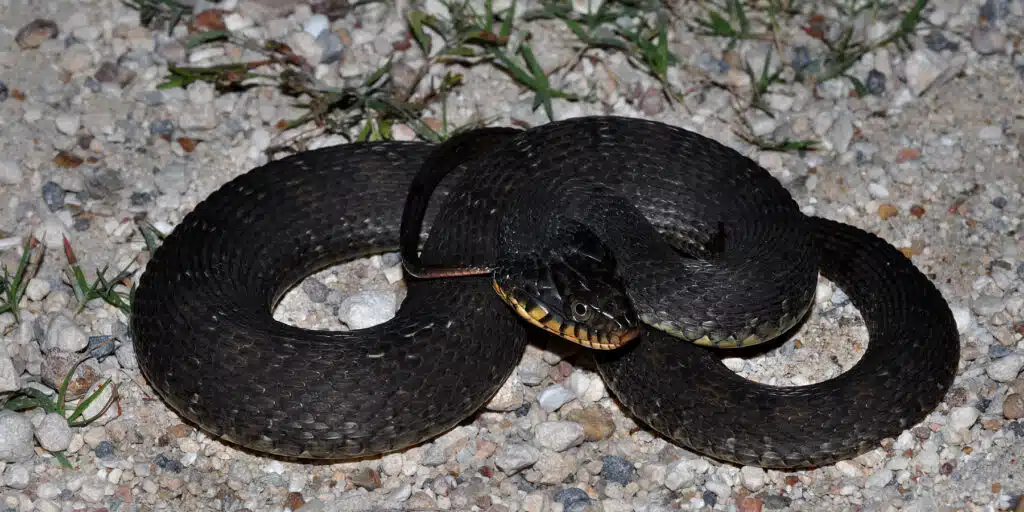
Plain-bellied Water Snakes (Nerodia erythrogaster) are an example species that used to be highly common in aquatic areas of the state, mainly around lakes.
This snake faces a diminishing habitat and it’s now listed as a threatened snake in Ohio.
Much of the life of the species is tied to undisturbed habitats and the presence of suitable prey.
Plain-bellied Water Snakes live next to ponds and lakes. Some may even live on adjacent streams and rivers.
The Plain-bellied Water Snake is among the typical species known to feed on crayfish, a prey that only lives in pure water without pollution.
Unlike other North American snakes that solely feed on crayfish, The Plain Bellied Watersnake also feeds on fish, frogs, and salamanders.
Ambushing techniques are used by this species to catch different types of prey such as crayfish and small fish.
Most Plain-bellied Water Snakes can’t be seen when they hunt as they lay underwater, waiting for prey to come to them.
These ambushing techniques result in the snake quickly swallowing prey.
A snake that’s mostly black dorsally, the species cannot be easily seen from above when looking for food in the water.
It’s only the juvenile Plain-bellied Water snakes that can be spotted as they have dark bands dorsally.